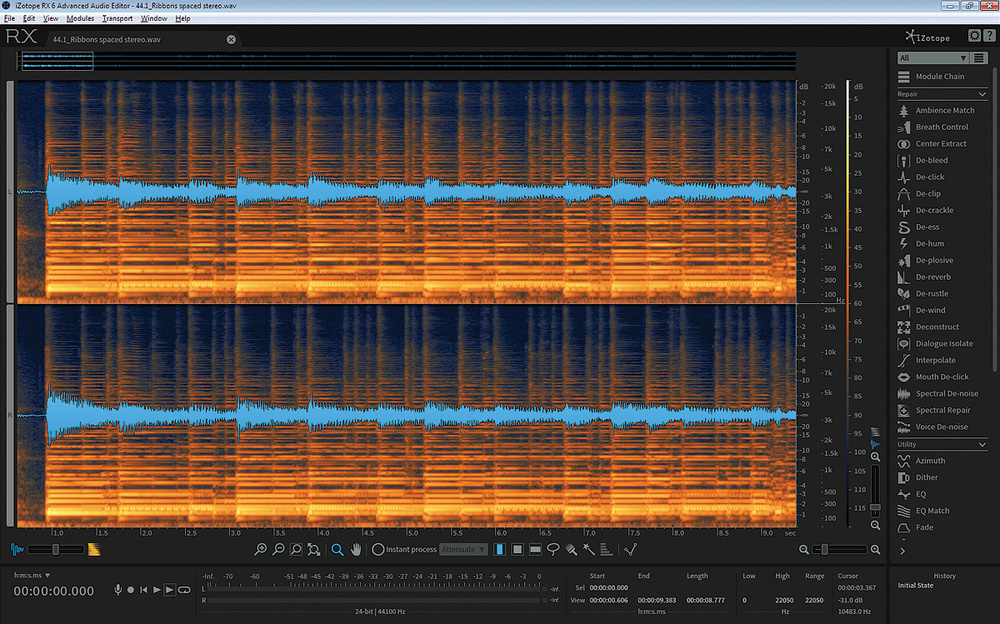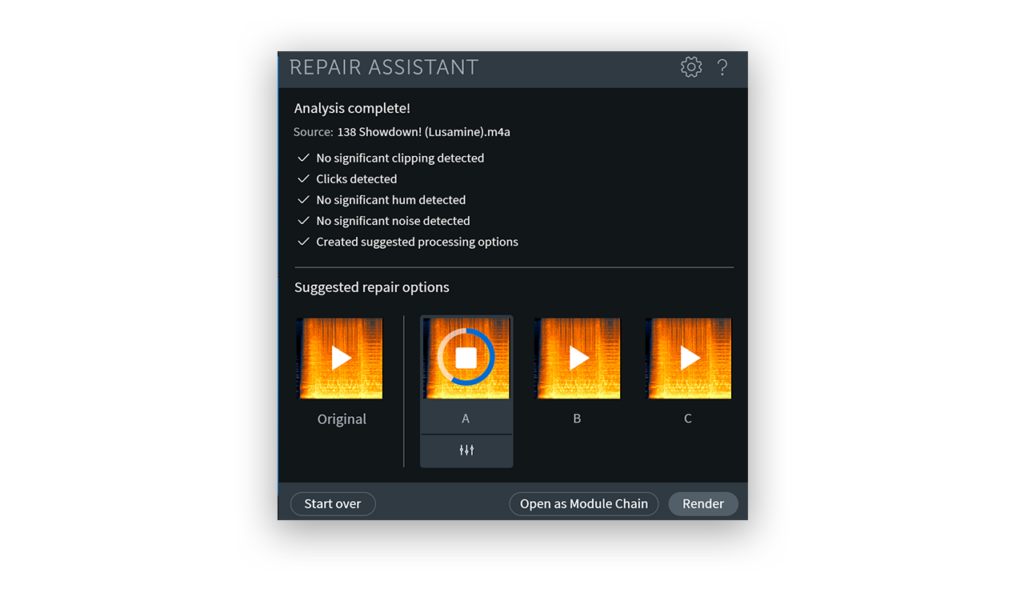Paint out distortion in the Spectrogram. We often think of De-clip, De-click, and De-crackle as.
- RX 3 master Mike Thornton (Mr RX It) reveals every feature and function of this in-depth industry standard solution, and shows RX 3 in action on real-world audio examples for a complete understanding of the RX 3 package. IZotope’s award-winning RX Audio Editor is the industry standard for audio repair, restoration, and enhancement.
- Navigate to the AudioSuite menu, find the “Noise Reduction” or “iZotope” sub-menu and select RX Connect. Select a clip in the Timeline and/or in the Clip List (depending on the Selection Reference mode you are using in the AudioSuite window) that you would like to process. Select Repair in the RX Connect window and then click Send.
How to Use Music Rebalance in RX 7 Sep 13, 2018. Isolate mix elements from a single track with the new source separation module in RX 7, Music Rebalance. Easily reduce vocals in background music for clearer dialogue, learn how to remove vocals from a song, or separate vocal stems from a track for easy remixing.
| Module & Plug-in |
|---|
Izotope Rx Voice Denoise Pro
Jan 13, 2020 Download iZotope RX 7 Audio Editor Advanced 7.01 free latest version offline setup for Windows 32-bit and 64-bit. Como baixar o studio one 4. IZotope RX 7 Audio Editor Advanced 7.01 is a very powerful audio restoration software with a variety of powerful features to enhance the. Oct 16, 2019 Re: iZotope RX7 Voice Denoise Post by tomorrowstops » Thu Oct 17, 2019 11:40 am I would get the noise reduction where you want it and then bounce that track down with it, and bring that file back in to do your edits. MacProVideo.com is an online education community for creative computer users. Our courses focus on artistic skills like Making Music, Video Editing, Graphic Design, 3D Modelling & Game Dev, Photography, and Web/Computer Programming.

- Note: You can use keyboard shortcuts Control-Shift-4 on a PC or Command-Shift-Option-4 on a Mac in order to train RX's de-noise based on your current selection. Learning a Noise Profile From More Than One Selection. In the RX standalone application, it is possible to create a spectral profile from multiple isolated selections.
- The Definitive Guide To Removing Noise From Audio. Did some audio recording and ended up having a noisy recording? You might still be able to save the audio with these restoration techniques, so don’t throw that audio away yet.
- Oct 20, 2019 Re: iZotope RX7 Voice Denoise Post by tomorrowstops » Thu Oct 17, 2019 11:40 am I would get the noise reduction where you want it and then bounce that track down with it, and bring that file back in to do your edits.
Overview
Voice De-noise is an intuitive, zero latency de-noiser that offers high quality results on a variety of material.
Voice De-noise can intelligently analyze speech signals and determine the best noise threshold for your signal. In a DAW, this feature can be used to write automation in case you need to override the automatic settings and correct the noise threshold by hand.
How does Voice De-noise processing work?
- Under the hood is a series of 64 psychoacoustically spaced bandpass filters which act as a multiband gate to pass or stop a signal based on user-defined threshold values.
- If a signal component is above the threshold for the filter, it will be passed (not processed).
- If a signal component is below the threshold for the filter, it will be attenuated (processed).
Controls
Izotope Rx 6 Voice Denoise

ADAPTIVE MODE: Analyzes the incoming signal and adjust the noise threshold automatically to compensate for changes in the noise floor. This can be useful for removing noise from recordings with variable noise floor and continual noisy sections, and works well for almost any recording of dialogue and spoken word.
Adaptive mode considerations
- The noise threshold settings in Adaptive Mode may be different from the settings achieved by running Learn to set the noise threshold manually.
- Because the adaptive noise threshold is continually being adjusted, it is set lower to prevent artifacts from occurring.
- The noise threshold settings in Adaptive Mode may be different from the settings achieved by running Learn to set the noise threshold manually.
LEARN: When using Manual mode, you can use the Learn button to set the noise threshold to a noise reference.
Tips for Learning a noise profile
- Find a passage of pure noise in your audio and use Learn to analyze it.
- Longer selections of noise will set the Threshold Nodes to more ideal locations.
- We recommend finding at least one second of pure noise to Learn your noise profile from.
- Find a passage of pure noise in your audio and use Learn to analyze it.
OPTIMIZE FOR DIALOGUE OR MUSIC: Because dialogue tends to be in short bursts and vocals tend to have sustained notes, we’ve added modes to provide better results when applying Voice De-noise processing.
- Optimize for DIALOGUE reacts to noise changes faster and isn’t meant to handle the noise found in sung vocals.
- Optimize for MUSIC does not attenuate sustained notes and is more transparent when applied to sung vocals.
- Optimize for DIALOGUE reacts to noise changes faster and isn’t meant to handle the noise found in sung vocals.
THRESHOLD NODES: The Threshold Node controls on the frequency spectrum display allow you to modify the noise threshold curve, which can be thought of as the “noise profile.” These six points can be adjusted manually to suit the noise currently in your signal. These controls can be automated to compensate for shifts in the audio’s noise floor.
- In ADAPTIVE Mode, the Threshold Nodes are adjusted automatically in real-time.
- In MANUAL mode, more than one Threshold Node can be selected at a time for manual adjustment by clicking and dragging anywhere on the interface.
- In ADAPTIVE Mode, the Threshold Nodes are adjusted automatically in real-time.
THRESHOLD: The master Threshold control allows you to offset all Threshold Node values by the same amount. If you find that processing is too aggressive or processing is affecting audio you want to leave unprocessed, try adjusting this control.
REDUCTION: Provides control over the maximal depth of noise reduction (in dB) that will occur per frequency band while a signal component is below its threshold. If you have your thresholds set properly and don’t like the results you’re getting, try adjusting this control.
METERING
- The Input Spectrum meter shows the level of the signal at the input of the denoiser filters.
- The Output Spectrum meter shows the level of the signal at the output of the denoiser filters.
- The Gain Reduction Region is the area between the Input and Output Spectra. This shows the amount of noise reduction processing being applied to your signal.
- The Input Spectrum meter shows the level of the signal at the input of the denoiser filters.
Voice De-noise Plug-in
Izotope Voice Denoise
Voice De-noise has been specifically designed to provide high efficiency, zero latency adaptive noise removal when inserted on a track in your DAW or NLE. The Spectral De-noise plug-in is far more resource intensive and uses higher latency.

Spectral Repair is a module available in iZotope RX 7 Standard and RX 7 Advanced audio restoration software that lets you remove and replace unwanted sounds and frequencies in audio.
Two things make Spectral Repair much more precise at removing problem sounds than simple EQ’ing or filtering: 1. visualization of the audio and 2. algorithm-based audio repair. iZotope’s detailed visualization of the audio shows you a lot more than the waveform commonly displayed in your DAW. With this visualization, you can see different aspects of the audio, and then use one of the selection tools to trace around the problem areas. This is where the algorithm-based repair comes in.
Spectral Repair analyzes the audio surrounding the part you selected and uses that information to fill in the gaps that are left after the unwanted audio is deleted. If that is a bit confusing, it’ll make more sense once we get into the different processing modes.
Modes
Attenuate: Reduces magnitude of selection compared to audio outside of selection. Good for bringing down level of unwanted sounds like door slams or chair squeaks.
Replace: Completely replaces selection with audio outside selection. Good for unwanted sounds that completely obscure the other, wanted audio.
Pattern: Finds the most similar portion of audio outside selection and uses that info to replace the selected problem audio. Use if your source audio is badly damaged and/or has repeated parts.
Partials and Noise: A more advanced version of Replace mode. Uses harmonic synthesis to replace audio. Can correct pitch modulation such as vibrato.

iZotope RX-7: A First Look
Get a head start on this powerful software | READ »
Izotope Rx 7 Rx Failed To Apply The Selected Processing Center
By accurately selecting the parts you don’t want in your recording and trying out the different modes, some pretty impressive audio repair is possible. I tried two different applications.
The first test was to remove a problem frequency from a snare track, without the phase issues and over-processed sound that sometimes happen with extreme EQ settings. This snare recording had a bit of muddiness in the low-mid range, so I selected the muddy frequency using the Brush tool in the RX 7 Audio Editor:
After I selected that frequency, I opened the Spectral Repair module and tried the different algorithm modes to see what worked best. I ended up going with the Attenuate mode. I turned the Strength setting all the way up to 4 to exaggerate the effect of the processing, but in a real-life situation I’d probably use 1 or 2, so the snare doesn’t get too thin-sounding. As you can see in the screenshot below, the Compare Settings window lets you preview the audio both before and after processing, and then (if you like the result) you can hit Render in the main Spectral Repair window to apply the processing.
After applying the processing, you can see the attenuated frequency on the first snare hit, as compared to the later hits:
Here’s the audio of the snare track before processing:
And after:
For a more dramatic example of removing a problem sound, I tried something different. I took a recorded track of live drums and added an obnoxious sampled saxophone note to see if Spectral Repair could deal with it. In the screenshot below you can see the saxophone note as a series of horizontal lines (probably representing the different harmonics of the note):
For this one, the Attenuate and Replace modes seemed to be leaving a gap in the audio where the selection was, without much of the original drum recording left. But the Pattern mode did an amazing job of deleting the saxophone note while leaving the drums completely audible. I had to adjust the “surrounding region length [%]” control a bit before the algorithm got the rhythm right.
However, once I did that, the results were pretty impressive:
Here’s the original drum track:
Here’s the drum track with added saxophone note:
Izotope Rx 7 Upgrade
And here’s the track after processing with RX 7 Spectral Repair: